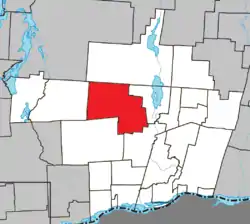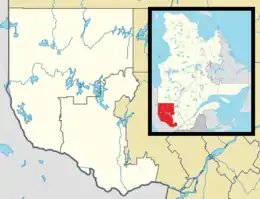Montpellier, Quebec
Montpellier is a town and municipality in the Papineau Regional County Municipality in the Outaouais region of Quebec, Canada. The town is located 30 kilometres (19 mi) northwest of Papineauville.
Montpellier | |
|---|---|
 | |
 Location within Papineau RCM | |
 Montpellier Location in western Quebec | |
| Coordinates: 45°51′N 75°10′W[1] | |
| Country | Canada |
| Province | Quebec |
| Region | Outaouais |
| RCM | Papineau |
| Settled | 1890s |
| Constituted | October 11, 1920 |
| Government | |
| • Mayor | Pierre Bernier |
| • Federal riding | Argenteuil—Papineau—Mirabel |
| • Prov. riding | Papineau |
| Area | |
| • Total | 266.00 km2 (102.70 sq mi) |
| • Land | 249.14 km2 (96.19 sq mi) |
| Population (2016)[3] | |
| • Total | 985 |
| • Density | 4.0/km2 (10/sq mi) |
| • Pop 2011-2016 | |
| • Dwellings | 896 |
| Time zone | UTC−5 (EST) |
| • Summer (DST) | UTC−4 (EDT) |
| Postal code(s) | J0V 1M0 |
| Area code(s) | 819 |
| Highways | |
| Website | montpellier |
The municipality includes the settlements of Montpellier and Lac-Schryer. Its western portion consists mostly of undeveloped Laurentian Hills, part of the Papineau-Labelle Wildlife Reserve.
History
In the late 19th century, pioneers arrived in the area searching for work in logging and agriculture. In 1882, in the north-west of what would later become the village, the forestry company W.C. Edwards opened a project to exploit timber at Muskrat Lake. Under the supervision of foreman, a man named Schraire, the log drivers brought logs down the creek to Lake Schryer to reach the saw mill downstream of the lake.[4]
Settlement occurred slowly along the shores of Lake Schryer. In 1892, Louis Beaulieu, called Montpellier, settled here on a farm and opened a post office and general store. After his marriage to Albina Bissonnette, they settled in the village known as Montpellier today. Shortly after, Moses Faubert left Mulgrave Township and settled here with his sixteen children. Several other families from neighboring townships came to reside in the village, contributing to the development of the small community.[4][5]
In 1900, construction began on a chapel at the village center. On 25 September 1902, the mission of Notre-Dame-de-la-Consolation was founded, and on 21 October 1907, the Archbishop of Ottawa decreed the establishment of the parish. On 23 October 1920, the Municipality of Montpellier was formed, matching the boundaries of the parish.[4]
In 1998, the southern portion of the Lac-des-Écorces Unorganized Territory was annexed by Montpellier, adding about 136 square kilometres (53 sq mi) and more than doubling its size.[5]
Demographics
| Canada census – Montpellier community profile | |||
|---|---|---|---|
| 2016 | 2011 | ||
| Population: | 985 (-0.1% from 2011) | 986 (2.1% from 2006) | |
| Land area: | 249.14 km2 (96.19 sq mi) | 248.34 km2 (95.88 sq mi) | |
| Population density: | 4.0/km2 (10/sq mi) | 4.0/km2 (10/sq mi) | |
| Median age: | 58.1 (M: 58.8, F: 57.4) | 56.1 (M: 56.2, F: 55.8) | |
| Total private dwellings: | 896 | 789 | |
| Median household income: | $45,184 | $37,456 | |
| References: 2016[6] 2011[7] earlier[8] | |||
| Year | Pop. | ±% |
|---|---|---|
| 1986 | 647 | — |
| 1991 | 734 | +13.4% |
| 1996 | 835 | +13.8% |
| 2001 | 734 | −12.1% |
| 2006 | 966 | +31.6% |
| 2011 | 986 | +2.1% |
| 2016 | 985 | −0.1% |
| Source: Statistics Canada | ||
Mother tongue:[3]
- English as first language: 3.0%
- French as first language: 94.9%
- English and French as first language: 1.0%
- Other as first language: 1.0%
Local government
List of former mayors:
- Rhéo Faubert (2001–2005)
- Stéphane Séguin (2005–2009)
- Pierre Bernier (2009-2013)
- Stéphane Séguin (2013–present)
References
- Reference number 42155 of the Commission de toponymie du Québec (in French)
- Geographic code 80090 in the official Répertoire des municipalités (in French)
- "(Code 2480090) Census Profile". 2016 census. Statistics Canada. 2017.
- "Histoire de Montpellier" (in French). Municipalité de Montpellier. Archived from the original on 2009-03-01. Retrieved 2008-10-31.
- "Montpellier (Municipalité)" (in French). Commission de toponymie du Québec. Retrieved 2008-10-31.
- "2016 Community Profiles". 2016 Canadian Census. Statistics Canada. February 21, 2017. Retrieved 2020-01-30.
- "2011 Community Profiles". 2011 Canadian Census. Statistics Canada. July 5, 2013. Retrieved 2020-01-30.
- "2001 Community Profiles". 2001 Canadian Census. Statistics Canada. February 17, 2012.
External links
 Media related to Montpellier, Quebec at Wikimedia Commons
Media related to Montpellier, Quebec at Wikimedia Commons